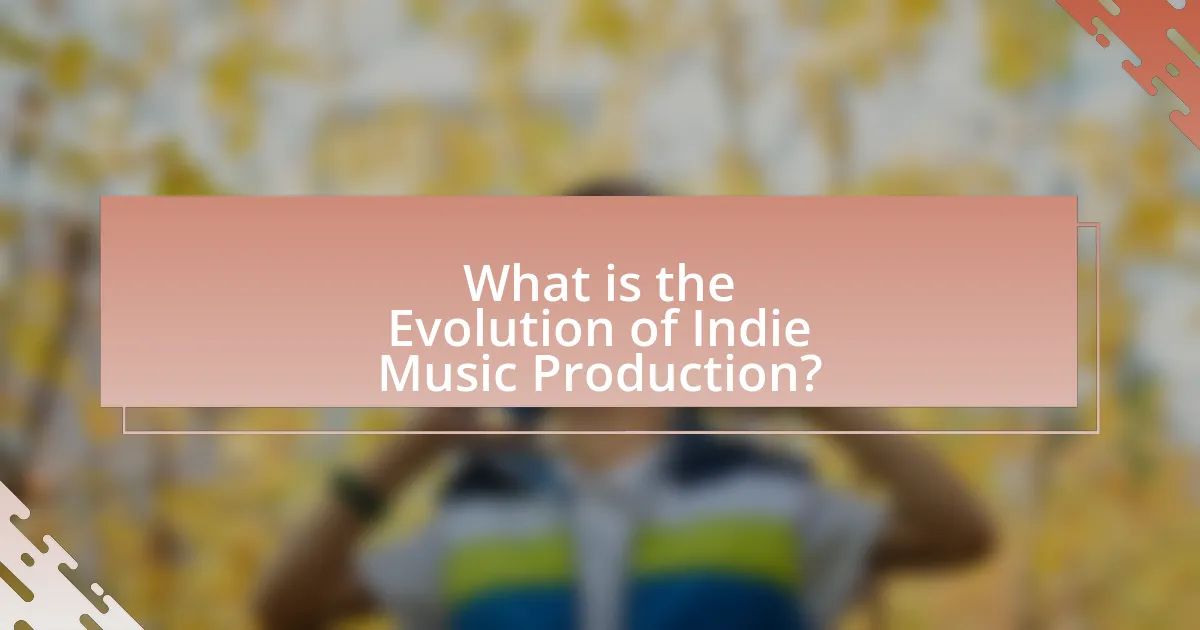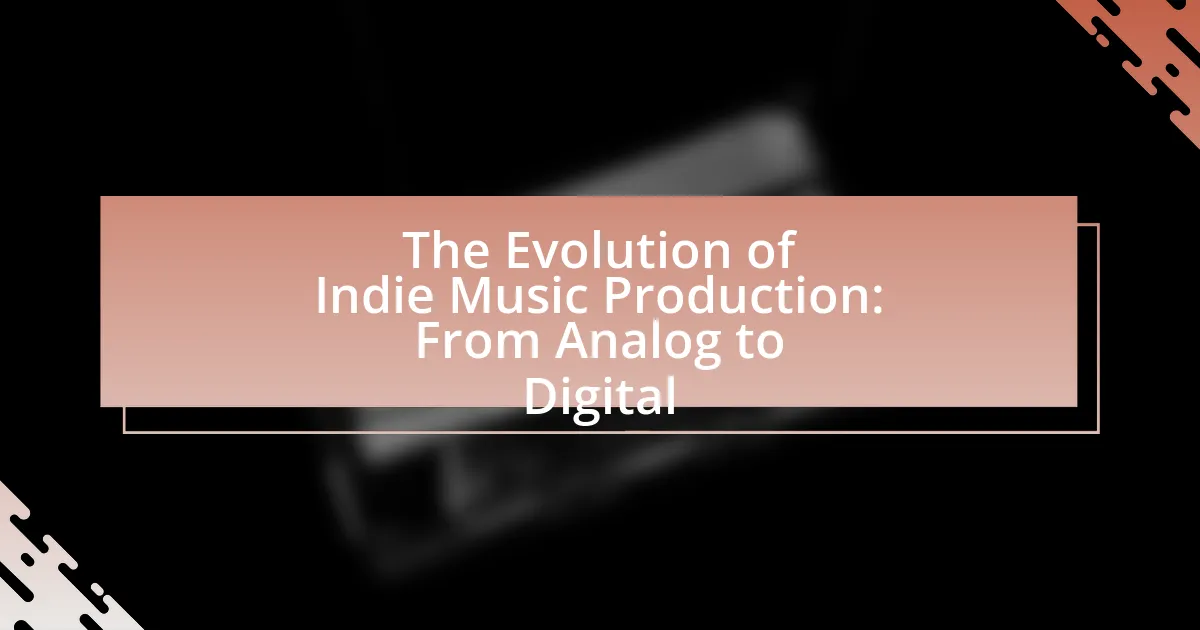The article examines the evolution of indie music production, highlighting the transition from analog methods to digital technologies. It details how advancements in recording techniques and the rise of affordable digital audio workstations have empowered independent artists, allowing for greater creative control and accessibility. Key milestones, such as the emergence of independent record labels and digital distribution platforms, are discussed, along with the impact of home studios on the indie music scene. The article also addresses the challenges faced by indie musicians in the digital age, including market saturation and financial constraints, while exploring future trends and best practices for maintaining artistic integrity in music production.

What is the Evolution of Indie Music Production?
The evolution of indie music production has transitioned from analog methods to digital technologies, significantly altering how music is created and distributed. Initially, indie music production relied on analog recording techniques, which involved physical media like tape and vinyl, limiting accessibility and requiring substantial financial investment for studio time. With the advent of digital technology in the late 20th century, particularly the introduction of affordable digital audio workstations (DAWs) and home recording equipment, independent artists gained unprecedented control over their production processes. This shift allowed for greater experimentation and creativity, as musicians could produce high-quality recordings without the constraints of traditional studio environments. The rise of the internet further facilitated this evolution by enabling artists to distribute their music directly to audiences, bypassing traditional record labels and distribution channels. As a result, indie music production has become more democratized, fostering a diverse range of sounds and styles that reflect the unique voices of independent artists.
How has indie music production changed over the decades?
Indie music production has evolved significantly over the decades, transitioning from analog methods to digital technologies. In the 1970s and 1980s, indie artists primarily relied on analog recording techniques, which involved expensive studio time and limited access to high-quality equipment. The introduction of affordable digital recording software in the 1990s, such as Pro Tools, democratized music production, allowing independent musicians to create high-quality recordings from home studios. By the 2000s, the rise of digital distribution platforms like Bandcamp and SoundCloud further transformed the landscape, enabling artists to reach global audiences without traditional label support. This shift has led to a surge in diverse sounds and styles within the indie genre, as artists now have greater creative control and access to a wider array of tools and resources.
What were the key characteristics of analog music production?
The key characteristics of analog music production include the use of physical media, such as magnetic tape, to capture sound, and the reliance on analog equipment like tape recorders, mixers, and synthesizers. Analog production is characterized by its warm sound quality, which results from the natural compression and harmonic distortion inherent in analog devices. Additionally, the process often involves manual manipulation of sound through techniques like tape splicing and the use of outboard gear, which adds a unique character to recordings. Historical context shows that analog recording dominated the music industry until the late 20th century, when digital technology began to emerge, leading to a significant shift in production methods.
How did technological advancements influence indie music production?
Technological advancements significantly influenced indie music production by democratizing access to high-quality recording tools and software. The introduction of affordable digital audio workstations (DAWs) like Pro Tools and Ableton Live allowed independent artists to produce music at home, reducing reliance on expensive studio time. Additionally, advancements in audio interfaces and microphones improved sound quality, enabling indie musicians to achieve professional results without major label backing. The rise of online distribution platforms, such as Bandcamp and SoundCloud, further empowered indie artists by providing direct access to audiences, bypassing traditional gatekeepers in the music industry. These changes collectively transformed the landscape of music production, allowing for greater creativity and diversity in the indie music scene.
Why is the transition from analog to digital significant?
The transition from analog to digital is significant because it revolutionized the way music is produced, distributed, and consumed. Digital technology allows for higher fidelity sound, easier editing, and more efficient storage compared to analog formats. For instance, digital audio workstations (DAWs) enable musicians to manipulate sound with precision, leading to innovative production techniques that were not possible with analog equipment. Additionally, the rise of digital distribution platforms has democratized access to music, allowing independent artists to reach global audiences without the need for traditional record labels. This shift has fundamentally changed the landscape of the music industry, making it more accessible and diverse.
What advantages does digital production offer over analog?
Digital production offers several advantages over analog, including enhanced flexibility, superior sound quality, and greater efficiency. Digital systems allow for easy editing and manipulation of audio tracks, enabling producers to experiment with sounds and arrangements without the limitations of physical media. Additionally, digital formats can achieve higher fidelity and dynamic range, resulting in clearer and more detailed recordings. The efficiency of digital production is further evidenced by the ability to store and access vast libraries of sounds and samples, streamlining the creative process. These benefits have led to a significant shift in the music industry, with a growing preference for digital tools among indie producers.
How has the accessibility of digital tools impacted indie artists?
The accessibility of digital tools has significantly empowered indie artists by enabling them to produce, distribute, and promote their music independently. This democratization of music production allows artists to create high-quality recordings at a fraction of the cost compared to traditional methods, with software like Ableton Live and Pro Tools available for home studios. According to a 2020 report by the International Federation of the Phonographic Industry, over 70% of independent artists now utilize digital platforms for distribution, illustrating a shift from reliance on record labels to self-sufficiency. This shift not only enhances creative control but also increases the potential for direct engagement with audiences through social media and streaming services, further solidifying the impact of accessible digital tools on the indie music landscape.

What are the key milestones in the evolution of indie music production?
The key milestones in the evolution of indie music production include the rise of independent record labels in the 1980s, the advent of affordable recording technology in the 1990s, and the impact of digital distribution in the 2000s. Independent record labels, such as Sub Pop and Matador, emerged in the 1980s, allowing artists to produce and distribute music outside of major label control. The introduction of affordable recording equipment and software in the 1990s democratized music production, enabling artists to create high-quality recordings at home. The shift to digital distribution platforms like Bandcamp and SoundCloud in the 2000s further transformed indie music production by providing artists with direct access to audiences, bypassing traditional distribution channels. These milestones collectively shaped the landscape of indie music, fostering creativity and independence among artists.
What role did home studios play in the indie music scene?
Home studios significantly democratized music production in the indie music scene by allowing artists to create high-quality recordings without the financial burden of traditional studio costs. This shift enabled a broader range of musicians to produce and distribute their work independently, fostering creativity and innovation. The rise of affordable recording technology in the late 1990s and early 2000s, such as digital audio workstations and inexpensive microphones, facilitated this trend. As a result, many successful indie artists, like Bon Iver and Sufjan Stevens, began their careers by recording in home studios, illustrating the profound impact of this practice on the indie music landscape.
How did the rise of affordable recording technology change the landscape?
The rise of affordable recording technology democratized music production, allowing independent artists to create and distribute their work without the need for expensive studio time. This shift enabled a surge in the number of musicians and diverse genres, as artists could produce high-quality recordings from home using accessible tools like digital audio workstations and affordable microphones. For instance, the introduction of software like Pro Tools and GarageBand in the early 2000s made professional-grade recording capabilities available to anyone with a computer, leading to a significant increase in the volume of music released. Consequently, this accessibility transformed the music industry, fostering a vibrant indie scene and reducing the gatekeeping traditionally held by record labels.
What impact did the internet have on indie music distribution?
The internet revolutionized indie music distribution by providing artists with direct access to global audiences without the need for traditional record labels. This shift enabled independent musicians to distribute their music through platforms like Bandcamp, SoundCloud, and Spotify, which collectively accounted for over 60% of music streaming revenue in 2021. Additionally, social media platforms facilitated grassroots marketing and fan engagement, allowing indie artists to build their brands and connect with listeners directly. The result was a democratization of music distribution, where artists could retain more control over their work and revenue streams, fundamentally altering the landscape of the music industry.
How have production techniques evolved with digital technology?
Production techniques have evolved significantly with digital technology by transitioning from analog methods to digital platforms that enhance accessibility, efficiency, and creativity. Digital audio workstations (DAWs) have replaced traditional recording equipment, allowing artists to record, edit, and mix music on personal computers, which reduces costs and increases the speed of production. For instance, software like Pro Tools and Ableton Live enables real-time editing and manipulation of sound, which was not possible with analog tape. Additionally, the rise of virtual instruments and plugins has expanded the sonic palette available to producers, allowing for greater experimentation and innovation in sound design. This shift has democratized music production, enabling independent artists to produce high-quality recordings without the need for expensive studio time, as evidenced by the increase in home studios and the proliferation of self-released music in the digital age.
What are the most common digital audio workstations used by indie artists?
The most common digital audio workstations (DAWs) used by indie artists include Ableton Live, FL Studio, Logic Pro, and Pro Tools. These DAWs are favored for their user-friendly interfaces, extensive features, and versatility in music production. For instance, Ableton Live is renowned for its live performance capabilities, while FL Studio is popular for its intuitive workflow and strong MIDI capabilities. Logic Pro is often chosen by Mac users for its comprehensive suite of tools, and Pro Tools is recognized for its industry-standard audio editing features. These preferences are supported by surveys and reports from music production communities, indicating that these DAWs dominate the indie music scene due to their accessibility and functionality.
How do modern production techniques differ from traditional methods?
Modern production techniques differ from traditional methods primarily through the use of digital technology, which allows for greater flexibility, efficiency, and precision in music creation. Traditional methods often relied on analog equipment, which limited the ability to edit and manipulate sound, whereas modern techniques utilize digital audio workstations (DAWs) that enable extensive editing, layering, and effects processing. For instance, the transition from tape recording to digital formats has significantly reduced production costs and time, as digital recordings can be easily duplicated and shared without quality loss. Additionally, modern techniques often incorporate software plugins and virtual instruments, expanding creative possibilities beyond the constraints of physical instruments and studio space. This shift has transformed the indie music landscape, allowing artists to produce high-quality recordings from home studios, thus democratizing music production.

What challenges do indie musicians face in the digital age?
Indie musicians face significant challenges in the digital age, primarily due to oversaturation and competition in the music market. With over 60,000 new tracks uploaded to streaming platforms daily, indie artists struggle to gain visibility and attract listeners. Additionally, the reliance on social media for promotion creates pressure to maintain a consistent online presence, which can be time-consuming and detracts from the creative process. Financial constraints also pose a challenge, as many indie musicians lack the resources for professional marketing and production, limiting their ability to compete with well-funded artists. Furthermore, the evolving landscape of digital rights and royalties complicates revenue generation, as artists often receive a fraction of a cent per stream, making it difficult to sustain a living solely from their music.
How does the saturation of the music market affect indie artists?
The saturation of the music market negatively impacts indie artists by making it more challenging for them to gain visibility and attract listeners. With an overwhelming number of releases, indie artists often struggle to stand out amidst mainstream competition and a plethora of content available on streaming platforms. According to a 2021 report by the International Federation of the Phonographic Industry, over 60,000 tracks are uploaded to Spotify daily, which dilutes audience attention and makes it harder for indie musicians to achieve significant reach. This saturation leads to increased competition for limited promotional opportunities and can result in lower revenue for indie artists, as they may find it difficult to monetize their work effectively in such a crowded environment.
What strategies can indie musicians use to stand out in a crowded field?
Indie musicians can stand out in a crowded field by leveraging unique branding, engaging storytelling, and innovative marketing strategies. Unique branding helps create a distinct identity that resonates with audiences; for instance, artists like Billie Eilish have successfully used visual aesthetics and personal narratives to differentiate themselves. Engaging storytelling in lyrics and social media can foster deeper connections with fans, as seen with artists who share personal experiences or behind-the-scenes content. Innovative marketing strategies, such as utilizing platforms like TikTok for viral challenges or collaborating with influencers, can significantly increase visibility; research indicates that 67% of users discover new music through social media platforms. By combining these strategies, indie musicians can effectively carve out a niche in the competitive music landscape.
How do financial constraints impact production quality for indie artists?
Financial constraints significantly reduce production quality for indie artists by limiting access to high-quality recording equipment, professional studios, and skilled personnel. Indie artists often rely on budget-friendly alternatives, which can lead to subpar sound quality and production values. For instance, a study by the Berklee College of Music found that artists with limited budgets frequently compromise on mixing and mastering, essential processes that enhance the final product’s clarity and impact. Consequently, the financial limitations faced by indie artists directly correlate with the overall quality of their music production.
What are the future trends in indie music production?
Future trends in indie music production include increased use of artificial intelligence for music creation, enhanced accessibility of high-quality production tools, and a shift towards decentralized distribution models. Artificial intelligence is being integrated into music production software, allowing artists to generate melodies, harmonies, and even lyrics, which streamlines the creative process. The proliferation of affordable digital audio workstations and plugins enables independent artists to produce professional-quality music without the need for expensive studio time. Additionally, blockchain technology is facilitating decentralized distribution, allowing artists to retain more control over their music and revenue streams, as evidenced by platforms like Audius and Ujo Music. These trends indicate a significant transformation in how indie music is created, produced, and distributed.
How might emerging technologies shape the next generation of indie music?
Emerging technologies will significantly shape the next generation of indie music by enabling artists to produce, distribute, and promote their work more efficiently and creatively. For instance, advancements in digital audio workstations (DAWs) and affordable recording equipment allow indie musicians to create high-quality music from home studios, reducing the need for expensive studio time. Additionally, platforms like Bandcamp and SoundCloud facilitate direct distribution to audiences, bypassing traditional record labels and empowering artists to retain more control over their music and revenue. Data analytics tools also provide insights into listener preferences, enabling targeted marketing strategies. According to a 2021 report by MIDiA Research, 40% of indie artists reported increased revenue through direct-to-fan sales, illustrating the impact of these technologies on the indie music landscape.
What role will social media play in the evolution of indie music production?
Social media will play a crucial role in the evolution of indie music production by providing platforms for artists to share their work, connect with audiences, and promote their music without the need for traditional record labels. This democratization of music distribution allows indie artists to reach global audiences directly, as evidenced by the fact that 70% of independent musicians use social media to promote their music, according to a 2021 survey by the Music Industry Research Association. Additionally, social media facilitates real-time feedback and engagement, enabling artists to refine their sound based on audience reactions, which can lead to more tailored and successful music production.
What best practices can indie musicians adopt for successful production?
Indie musicians can adopt several best practices for successful production, including investing in quality recording equipment, utilizing digital audio workstations (DAWs), and collaborating with experienced producers. Quality recording equipment enhances sound fidelity, which is crucial for professional-sounding tracks. According to a 2020 survey by the Music Industry Research Association, 70% of successful indie musicians reported that high-quality gear significantly improved their production quality.
Utilizing DAWs allows musicians to experiment with various sounds and effects, streamlining the production process. A study by the Berklee College of Music found that 85% of indie artists who used DAWs felt more empowered to create and produce their music independently. Collaborating with experienced producers can provide valuable insights and technical expertise, which can elevate the overall production quality. Research from the University of Southern California indicates that collaboration often leads to more innovative and polished music, as diverse perspectives contribute to the creative process.
How can indie artists effectively utilize digital tools for their music production?
Indie artists can effectively utilize digital tools for their music production by leveraging software like digital audio workstations (DAWs), virtual instruments, and online collaboration platforms. DAWs such as Ableton Live and Logic Pro X allow artists to record, edit, and mix music with professional quality, enabling them to produce high-fidelity tracks without the need for expensive studio time. Additionally, virtual instruments and plugins provide a wide range of sounds and effects, enhancing creativity and production quality. Online collaboration platforms like Splice and Soundtrap facilitate remote teamwork, allowing artists to work with producers and musicians globally, thus expanding their creative possibilities. These tools have democratized music production, making it accessible for indie artists to create and distribute their music independently.
What are the key considerations for maintaining artistic integrity in digital production?
Key considerations for maintaining artistic integrity in digital production include preserving the original vision of the artist, ensuring creative control, and balancing technological advancements with artistic expression. Artists must prioritize their unique sound and message, as digital tools can sometimes lead to overproduction or loss of authenticity. Maintaining a clear artistic direction amidst commercial pressures is crucial; for instance, a study by the Berklee College of Music highlights that artists who retain creative control often produce more authentic and resonant work. Additionally, understanding the implications of digital manipulation on the final product is essential, as excessive editing can detract from the emotional impact of the music.


